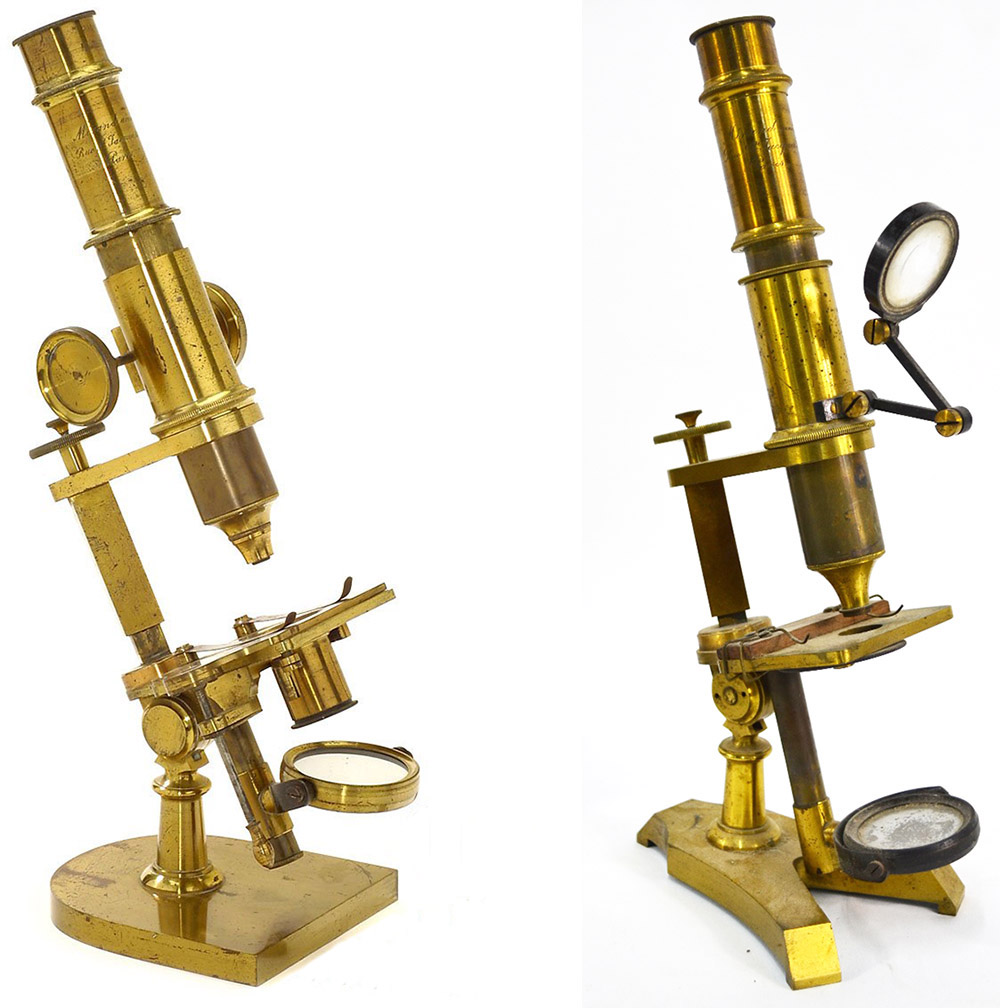
Figure 1. Two microscopes engraved "Mirand aîné, Rue St Jacques, Paris". Adapted for educational, nonprofit use from internet auction sites.
Antoine Mirand ("Mirand aîné"), ca. 1810 – ca. 1888
Jean Mirand (“Mirand fils”), 1843 - ca. 1910
by Brian Stevenson
last updated October, 2025
The Mirand family of Paris produced award-winning microscopes and other equipment, from 1846 through the end of the century. Microscopes with their names are occasionally seen. Others of their style may be found that are either unsigned or marked with other retailers’ names, indicating production as wholesalers. Following is a history of the father and son businesses of Antoine and Jean Mirand, gleaned from historical records and publications.

Figure 1.
Two microscopes engraved "Mirand aîné, Rue St Jacques, Paris". Adapted for educational, nonprofit use from internet auction sites.
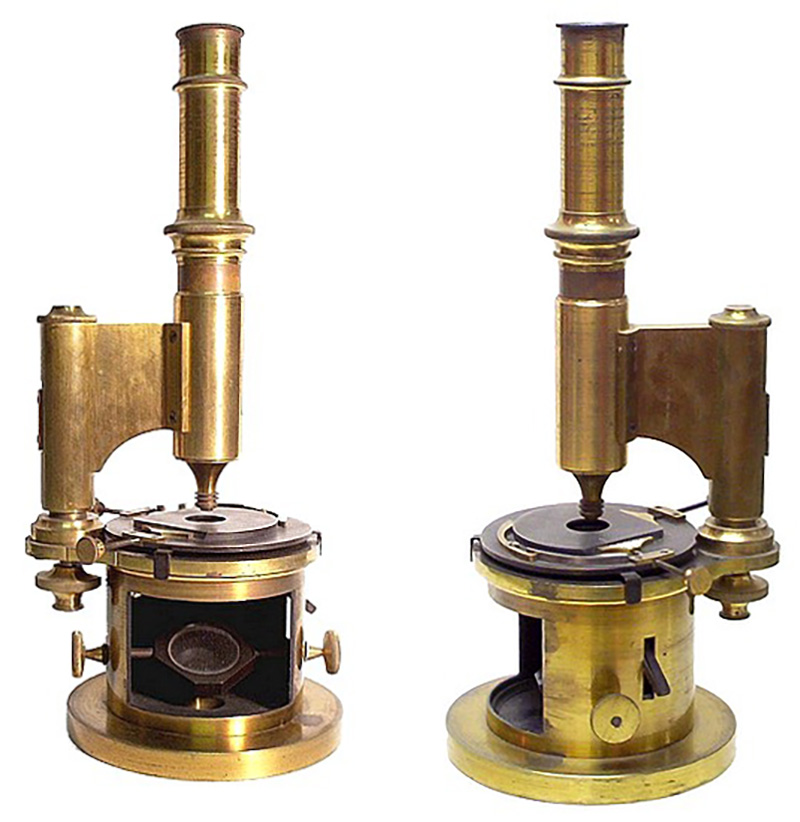
Figure 2.
A large drum microscope, unsigned. Another example is known that is signed "Manufactured for Flavelle Bros. & Co. par Mirand Aîné". Adapted, with permission, from http://www.antique-microscopes.com/photos/duhamel.htm.

Figure 3.
Examples of this microscope pattern are known that are signed "Mirand aîné", implying that Antoine Mirand was the most-likely manufacturer. Note the Varley- / White-type lever-adjusting stage, which a common feature of Mirand’s microscope, but rarely used by other French microscope-makers. Mirand’s use of “a moveable stage and a lever” was enthusiastically reviewed in 1867 by Hardwicke’s Science-Gossip. Left to right: Unsigned, signed "Elliot Brothers, London", marked "W.Y. McAllister, Philadelphia", and diagram from a catalogue of J. Queen, Philadelphia that was reproduced in J. King's 1859 "Microscopist's Companion". Images adapted, with permission, from http://www.antique-microscopes.com/photos/imported_French_microscope.htm, https://www.antiquemicroscopes.co.uk/m238.html, or from an internet auction site .
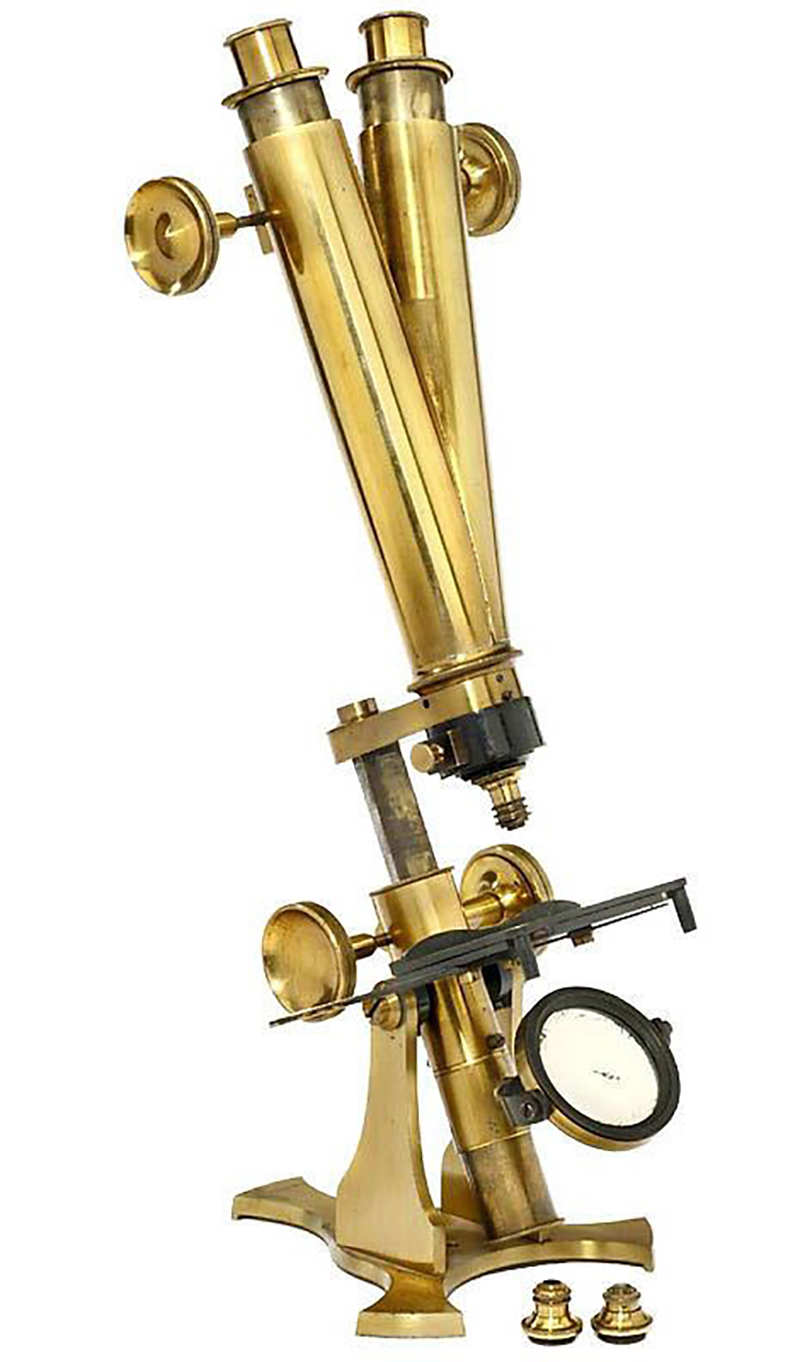
Figure 4.
A binocular microscope, signed “Mirand et Fils”, indicating manufacture when father and son worked together, ca. 1870. Adapted for educational, nonprofit use from an internet auction site.
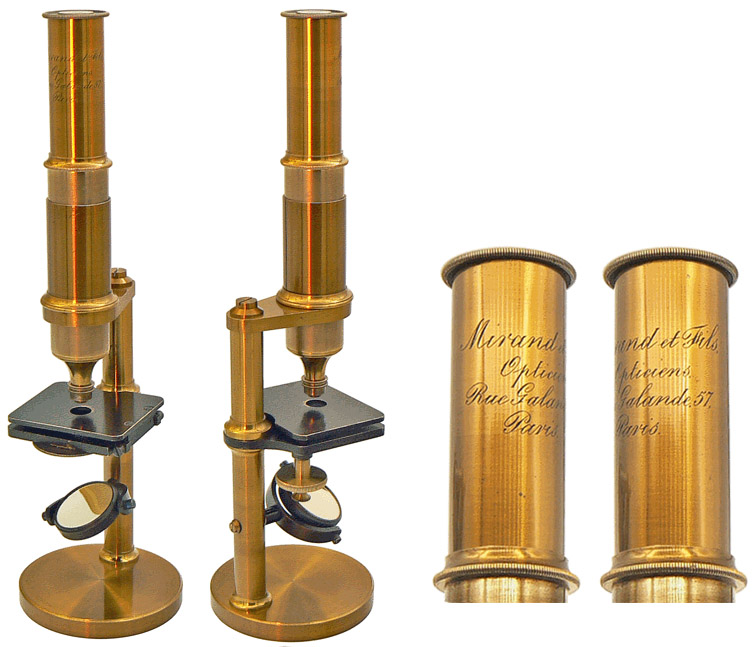
Figure 5.
A monocular microscope that is signed “Mirand et Fils”, circa 1870. Adapted with permission from http://www.lecompendium.com/dossier_optique_238_microscope_mirand/microscope_mirand.htm.
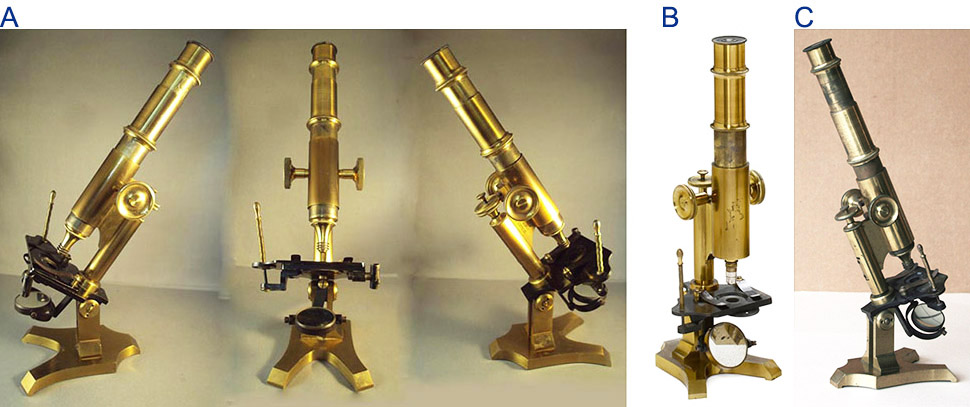
Figure 6A.
Three microscopes of the same form, all with lever-adjusting stages.
A.signed “Mirand Fils, Constr á Paris, R. Galande 57”.
B. An identical, unsigned microscope.
C. An essentially identical microscope, signed by Doninelli, of Nice, a provincial optician who prepared and sold eyeglasses, but who is not known to have manufacured microscopes.
Adapted by permission from
http://www.microscope-antiques.com/mirand.html, or for nonprofit, educational purposes from internet auction sites.
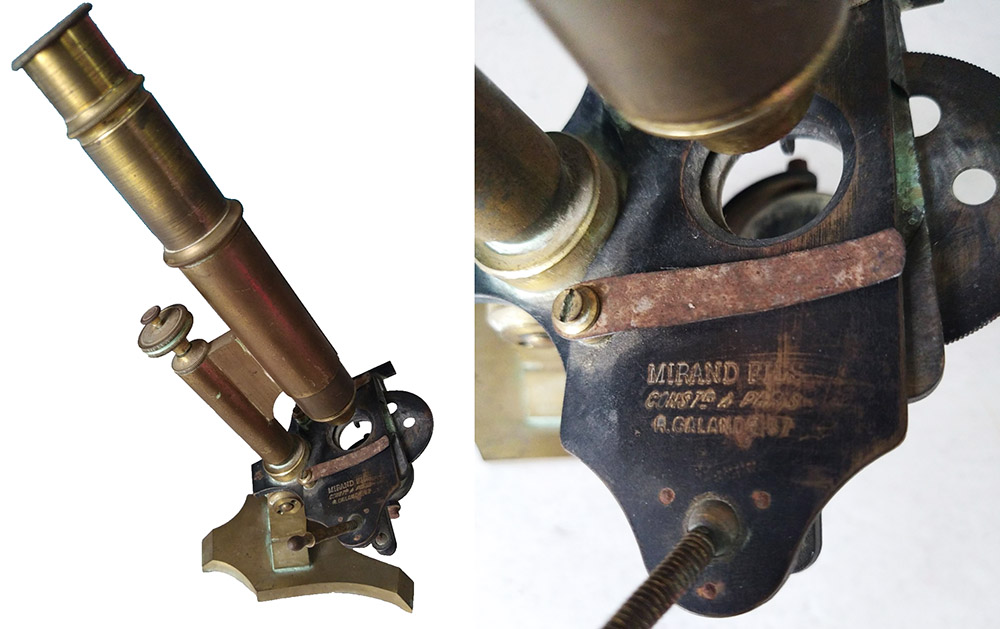
Figure 6B.
A microscope that is signed “Mirand Fils, Constr á Paris, R. Galande 57”, essentially the same model as shown in Figure 6A, but without rack-and-pinion coarse focusing. Adapted for nonprofit, educational purposes from internet auction sites.
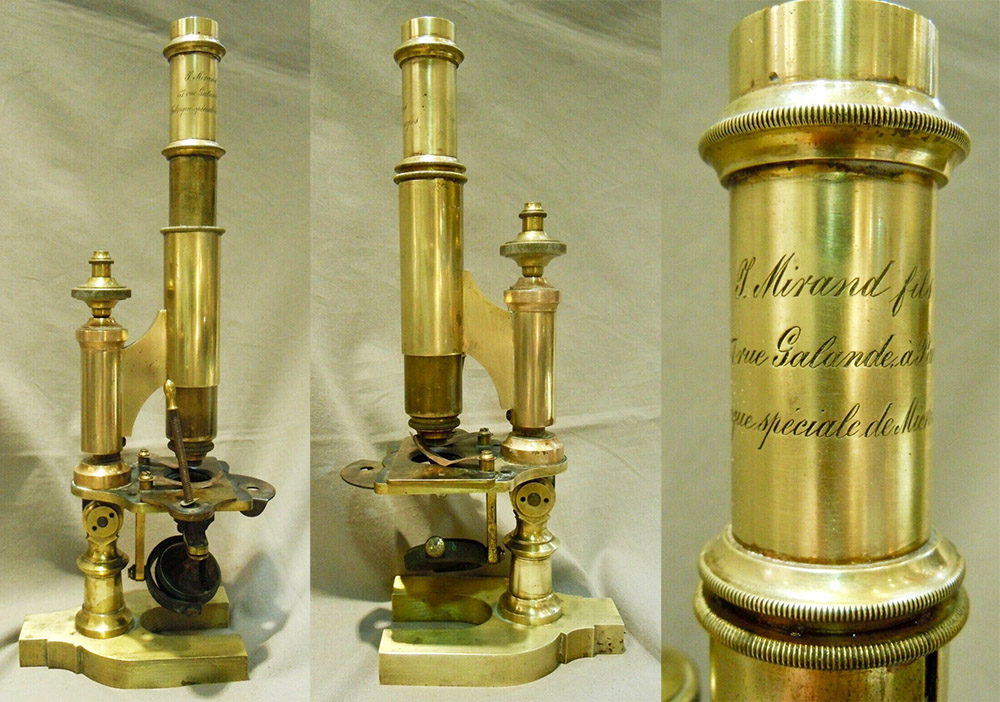
Figure 7.
A circa 1885 microscope, signed “J. Mirand Fils, Rue Galande, á Paris, Fabrique spécial de Microscopes”. Note the lever-action moveable stage. Images adapted for nonprofit, educational purposes from an internet auction site.
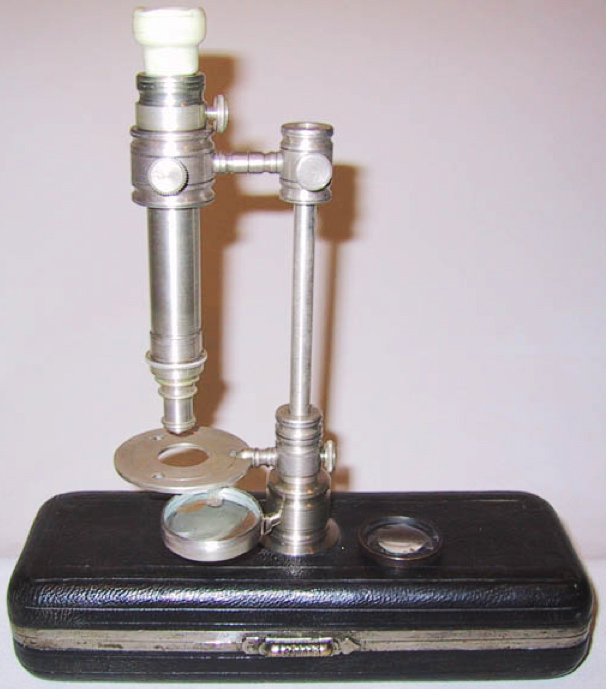
Figure 8.
A late 1800s portable microscope, signed by Mirand. At the 1889 Paris Exposition, he was noted to have displayed a pocket microscope that fits into a case “grand comme une boite à dominos” (the size of a dominoes box). Adapted for nonprofit, educational purposes from an internet retail site.
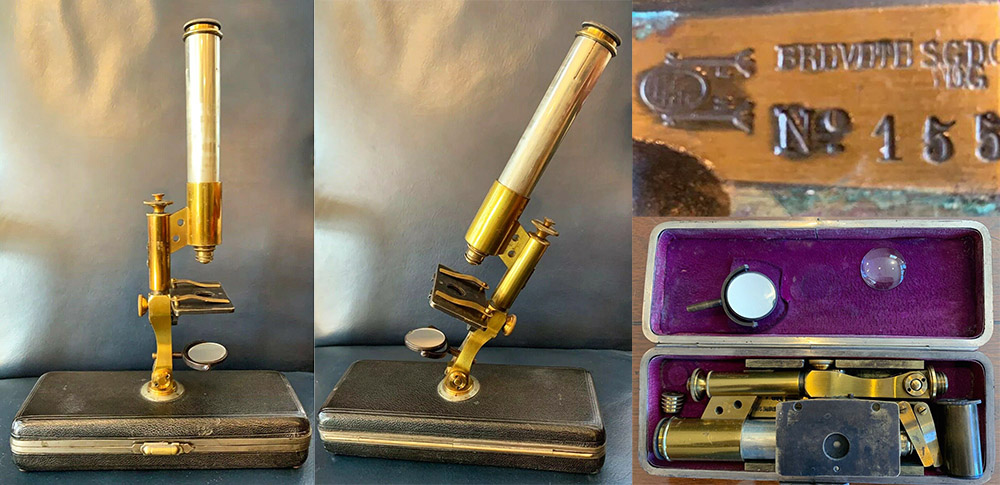
Figure 9.
A portable microscope that mounts onto the top of its carrying case, signed "Mirand Fils, Rue Galand 57". It is marked "brevette" ("patent"); Jean Mirand was awarded a patent in 1880 for a pocket microscope, which may have been this model. Images adapted for nonprofit, educational purposes from internet auction sites.
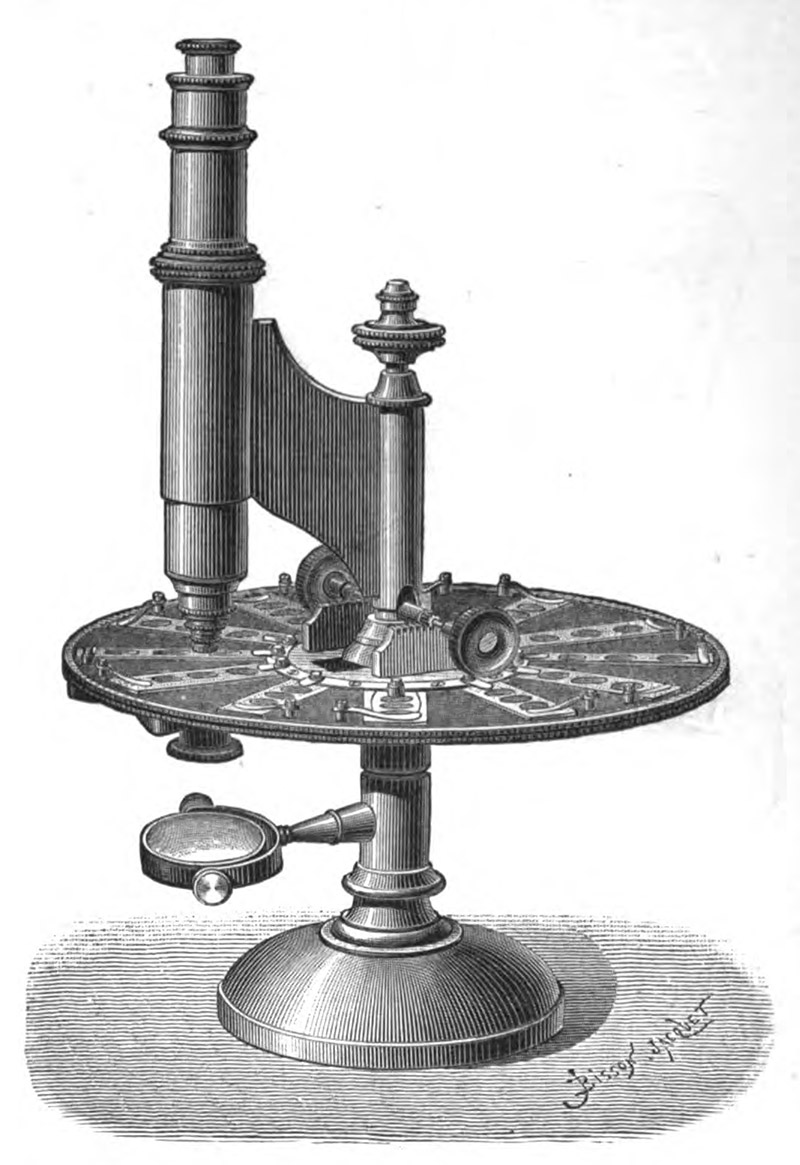
Figure 10.
An 1883 engraving of Jean Mirand’s revolving microscope, for use in schools or other demonstrations. It was described by the Royal Microscopical Society as “the stage can not only be rotated on its centre, but moved from back to front and vice versa, so that its centre does not coincide with that of the pillar. With this plan each of the twelve slides carried by the stage can have three different objects mounted upon them. If then the centre object on one of the slides is brought into the field of view, all those which occupy the same relative position on the other slides will pass under the objective when the stage is rotated. On turning the milled heads above the stage, the pinions connected with which work in rackwork attached to the stage, the latter is moved from back to front or vice versa so that the body-tube will stand over the first or third object on one of the slides. The rotation of the stage will then bring the correspondingly placed objects on each of the other slides under the objective as before”.
According to their children’s birth records, Antoine Mirand was married to Jean Rimaud. They had at least two children, Jean and Anne Marie (Figures 11 and 12).
An advertisement from Jean Mirand states that the Mirand business started in 1846 (Figure 13). A Parisian commercial directory, published for 1847, did not list Mirand, suggesting that he opened his shop in late 1846.
Antoine exhibited microscopes at the 1853 New York Exhibition of the Industry of All Nations, winning an Honorable Mention. A French report on the Exhibition listed him as “Mirand aîné" (Mirand the elder). The catalogue of the 1855 Paris Exposition listed “Mirand aîné (Ant.). a Paris. r. St-Jacques, 59 - Microscopes”, confirming that Mirand the elder was, indeed, Antoine. His only known son, Jean, was born in 1843, and it was hardly necessary to differentiate the father from his 10-12 year-old son. It is possible that Antoine may have had an older son, who operated a separate business, although no evidence for this has been found.
��Antoine’s address was variously reported as 59, 57, 56, or 52 Rue Galande, in addition to the above-noted 59 Rue Saint Jacques. Rue Galande and Rue St. Jacques intersect, so the shop may have had a door onto each street. It is not evident whether the various numbers of Mirand’s address were typographical errors, he moved locations, street numbering changed occasionally, or a location(s) had more than one numbered entrance.
Antoine exhibited at the 1862 London Exposition, “Mirand, A. Sen. Paris. - Microscopes”. An 1862 business directory of Paris included “Mirand aîné, opticien, Galande, 57”.
Son Jean evidently joined his father in business during the mid-1860s. The�� exhibited at the 1867 Paris Exposition as “Mirand (et fils), à Paris, rue Galande, 56.- Microscopes; lentilles. Chaque instrument porte une étiquette explicative. En face de sa vitrine, M. Mirand a établi un microscope dans lequel le public peut examiner des préparations fort bien faites et montées sur un disque, de façon à se présenter à la file sous l'objectif de l'instrument”. Paraphrased, “microscopes; lenses. Each instrument carries an explanatory label. In front of his showcase, Mr. Mirand set up a microscope through which the public may view well-made preparations, mounted on a disc, in order to view in a sequence under the lens of the instrument”.
An English report from that exposition remarked upon their microscopes: “First of all comes the discovery in the French department of a microscope with a moveable stage and a lever, and still more surprising a large microscope (not quite so large as No. 2 size of the London opticians), with two rack-work movements to the stage. I must add that the exhibitors of these phenomena are Mirand & Fils, Rue Galande, 52”. Microscopes matching that description are shown in Figures 3, 6, and 7 above.
That writer further elaborated on the simplicity and small size of French microscopes, relative to English instruments: “It is but fair to add that the Parisian opticians are not at fault in shunning stage movements and other improvements, but, as a friend writes me from another corner of the Continent, there is a reason at the bottom. ‘I read with interest,’ he says, ‘your remarks on the microscopes. You are certainly quite right in reflecting on the small dimensions of the continental instruments, and on the very general non-adoption of machine stages and inclining joints, but you might have given (if you could have done so without offence) the true reason - a desire for cheapness. A German or Frenchman likes the luxury of a Ross, Smith and Beck, or Powell and Lealand, as much as any one, and when they affect to despise English appliances on principle, I never believe them’.”
Even with the features they included in their microscopes, the Mirands targeted the low-price market. The report of the 1867 Paris Exposition stated, “Parmi les instruments à bon marché … M. Gundlach, en Prusse, et M . Mirand, en France, ont exposé des instruments supérieurs aux précédents par leur construction, et qui peuvent servir à des études sérieuses, malgré la modicité de leur prix. Ainsi M. Mirand donne pour 200 francs un microscope bien construit, avec quatre jeux d'objectifs. Il a également imaginé une disposition bien combinée, qui permet de réunir dans un seul et même instrument, du prix de 500 francs, le microscope d'observation et le microscope solaire”. Paraphrased, “Among the cheap instruments … Mr. Gundlach, from Prussia, and M. Mirand, from France, exhibited instruments of superior construction, which can be used for serious studies, despite the modest price. Mr. Mirand asks 200 Francs for a well-built microscope, with four sets of objectives. He also devised a well-made provision instrument that combines the observation microscope and solar microscope, for the price of 500 Francs”.
Jules Pelletan, in his 1876 Le Microscope, wrote of the resemblances between the microscopes of Mirand and English makers, “M. Mirand fils��, à Paris, construit des corps de microscopes qui se rapprochent beaucoup pour la forme et les dispositions des modèles Ross, Swift, Collins, etc.” He also wrote dismissively on the draw-tubes incorporated into microscopes by the English and by Mirand, “On peut encore obtenir une amplification en allongeant le tube du microscope ainsi que le font les opticiens anglais dont le tube a un tirage considérable et gradué, et M. Mirand, à Paris, qui fabrique des microscopes se rapprochant de la forme anglaise. Mais par ce moyen, on perd beaucoup de lumière, et l'on peut en faire l'expérience sur toute espèce de microscope: en soulevant l'oculaire, sans le retirer du tube, de manière à allonger celui-ci, on voit l'image grandir et s'assombrir en même temps”, (amplification can be obtained by prolonging the microscope tube, as do the English opticians whose tubes have a considerable, graduated draw, and Mr. Mirand in Paris, who manufactures microscopes approaching the English form. But in this way, we lose a lot of light, and you can experience it on any kind of microscope by lifting the eye without removing the tube, so as to lengthen it, we see the image grow and darken at the same time).
It appears that Antoine retired from business during the 1870s. Pelletan’s 1876 work, noted above, referred to the son alone. Later records similarly note the son but not the father. Our Antoine may have been the man of that name who died on December 18, 1888, in the Paris suburb of Le P��ré-St-Gervais.
Jean Mirand exhibited alone at the 1878 Paris Exposition, where he earned a Bronze Medal. A reviewer wrote, “Parmi les médailles de bronze, je ne citerai … M. Mirand, qui fabrique des stands sur les modèles anglais. Ce dernier méritait mieux, car ses instruments sont bien faits”, (Among the bronze, I will mention … Mr. Mirand, who manufactures stands on the English model. He deserved better because his instruments are well made).
Jean received a patent in 1880 for his “pochette micrographique” (pocket microscope). I have not located drawings that accompanied his patent application, but it presumably included features found in the Mirand portable microscope illustrated in Figure 9, above.
��Paris’ Société Centrale d’Apiculture et d’Insectologie awarded Mirand a Gold Medal in 1882: “Nous avons donné la médaille d'or du Ministre à M. Mirand, qui est parvenu à élever sa fabrication au niveau de nos grands opticiens, sans avoir fait subir à ses prix un mouvement parallèle. Nous signalerons aux professeurs sa platine tournante qui permet de mettre rapidement sous les yeux des élèves une série de ces admirables préparations microscopiques que M. Bourgogne exécute si bien et dont nous espérons en 1882 voir une série complète figurer dans nos galeries”, (We gave the Gold Medal of the Minister to Mr. Mirand, who raised his production to that of our major opticians, without similarly raising his prices. We note his teachers’ turntable that allows one to quickly show to students a series of admirable slides by Mr. Bourgogne, and we hope to see a complete set included in our galleries in 1882).
Jean took up production and sales of electric signals in the early 1880s, which sound very similar ��to those made earlier by his uncle. The catalogue of the 1881 Paris International Exposition of Electricity included, “Mirand (fils). Paris, 57, rue Galande. - Sonnettes électro-magnétiques”, and “Mirand (fils), Paris, 57, rue Galande. - Pointeur électro-magnétique à train différentiel du docteur Noël. - Enregistreur isochrone à signal électro-magnétique de Mirand. - Brachytotype du docteur Noël. - Microscope à platine chauffante à réglage électro-magnétique de Mirand”. J.A. Berly's Universal Electrical Directory and Advertiser, 1884, listed, “Mirand Fils., sonneries et signaux electriques, rue Galande, 57, Paris”.
He was awarded a patent in 1889 for a pocket-sized money calculator. His accompanying signature is reproduced in Figure 15.
Jean Mirand substantially altered the style of his microscopes in 1889, adopting patterns more in line with other French manufacturers. A review of the 1889 Paris Exposition (translated and paraphrased), “Mr. Mirand sent his microscopes … The showcase for Mr. Mirand is opposite Mr. Nachet’s table, leaning against the wall behind the large window of Leon Laurent, just in front of the door when you enter the room of Class 15 … There are not many exhibits, but the quality is better than others’. It should be noted first that Mr Mirand seems to have completely changed his models and his bill. He is to be congratulated. The manufacturer, long known in Paris, had once adopted English forms, like Ross or Pillischer. We remember, no doubt, he often adapted a stage with metal blades … which could be moved in various directions using a hinged lever. Mr. Mirand seems, to me, to have abandoned all that, and he did well. English models have value only insofar as they are large enough to receive all the mechanical improvements used by skilled builders from across the Channel. The models are far inferior to ours. And besides, anyone who wants an English microscope must buy in England; anyone who wants a French microscope should buy in France.
Today, he applies his construction and mechanic qualities to make the best microscopes, established on French models and newer. He exhibits two major instruments. One is a large format microscope mounted on a horseshoe foot, like those of Prazmowski or Verick. It can tilt, but the vortex stage, rotating with the microscope body and the tube was abandoned as indeed it should be. The stage, in this model, is square, extremely wide, and it revolved around the optical center a second circular plate. It is a ‘rotary’ stage in English, as is now commonly built in France. Under the stage is an Abbe lighting system, and, on the tube nose, a revolver with three objectives.
Both microscopes, very well built, are of good size, not too big nor too small, very well ‘in hand’ ... They are accompanied by a small pocket microscope, enclosed in a case the size of a dominos box, and two solar microscopes. Mr. Mirand has an old reputation for building such instruments.
Finally, this exhibition is completed by a revolver microscope, already known but very elegantly built. It is, in short, the model that George Adams built in the middle of the last century, improved and modernized. A large circular plate carries the vertical microscope body at its center. On this stage are placed twelve slides arranged along the radii of the circle. Each of them has three cells, essentially three slides. The stage has openings to allow illumination of each cell by the mirror. By rotating the stage, each of the slides is successively put under the lens. Additionally, the microscope body can move horizontally a few centimeters back and forth, such that the lens can be focused on each of the three preparations in the same slide. If one uses glass slides of approximately the same thickness, then 36 preparations can be arranged on the stage for view without needing to touch to the focus. This revolver microscope is obviously not a laboratory instrument; it is a salon or demonstration microscope”. Mirand’s revolving microscope is illustrated above in Figure 10, and two pocket microscopes are shown in Figures 8 and 9.
Jean Mirand was actively producing and exhibiting microscope in 1891. That year, he won a Diplôme d'Honneur for “ses microscopes et ses loupes”. His 1891 voter registration record described him as being an “opticien”, still at 57 Rue Galande. Those are the most recent records I found on Jean Mirand. He was only 48 years old in 1891, and so can be presumed to have lived and worked for another couple of decades.
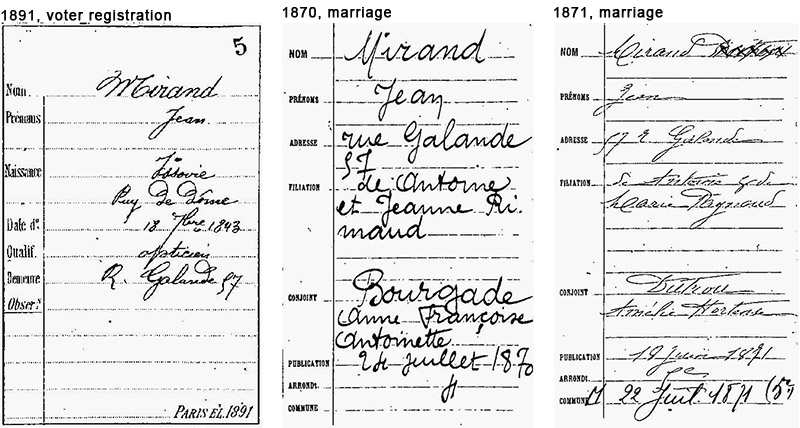
Figure 11.
Records of Jean Mirand. All provide the address of the Mirand optical shop of 57 Rue Galande. Jean’s 1891 voter registration form gives his birth date as June 18, 1843. Both marriage records give Jean’s father’s name as Antoine, and his mother as Jeanne Rimaud/Reynaud.
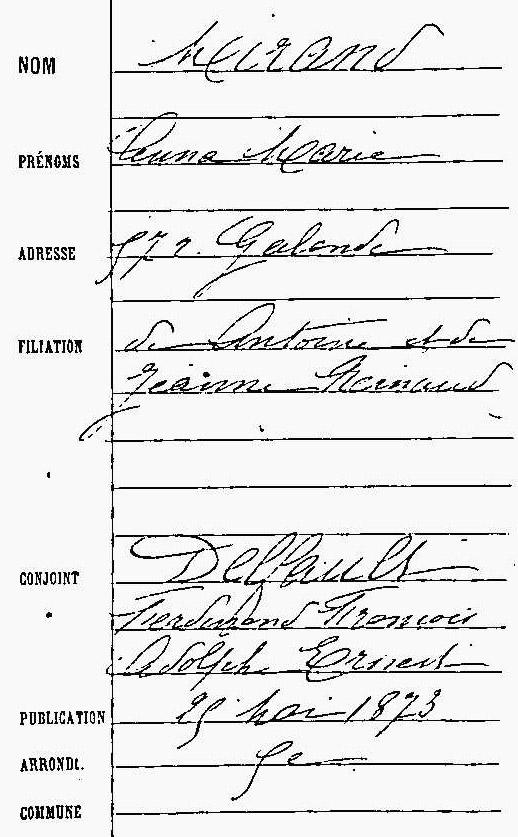
Figure 12.
May 29, 1873, marriage record of Anne Marie Mirand, daughter of Antoine and Jeanne Reinaud. Her address was given as 57 Rue Galande.
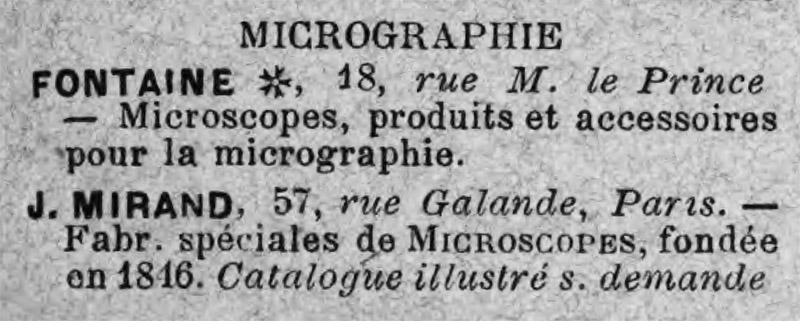
Figure 13.
An 1887 advertisement from Jean Mirand, which states that the business was founded in 1846.

Figure 14.
An 1887 advertisement from Jean Mirand.
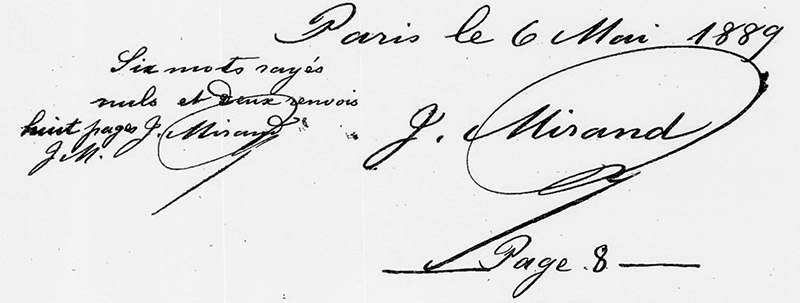
Figure 15.
Jean Mirand’s signature, from his 1889 patent application for a pocket calculator.
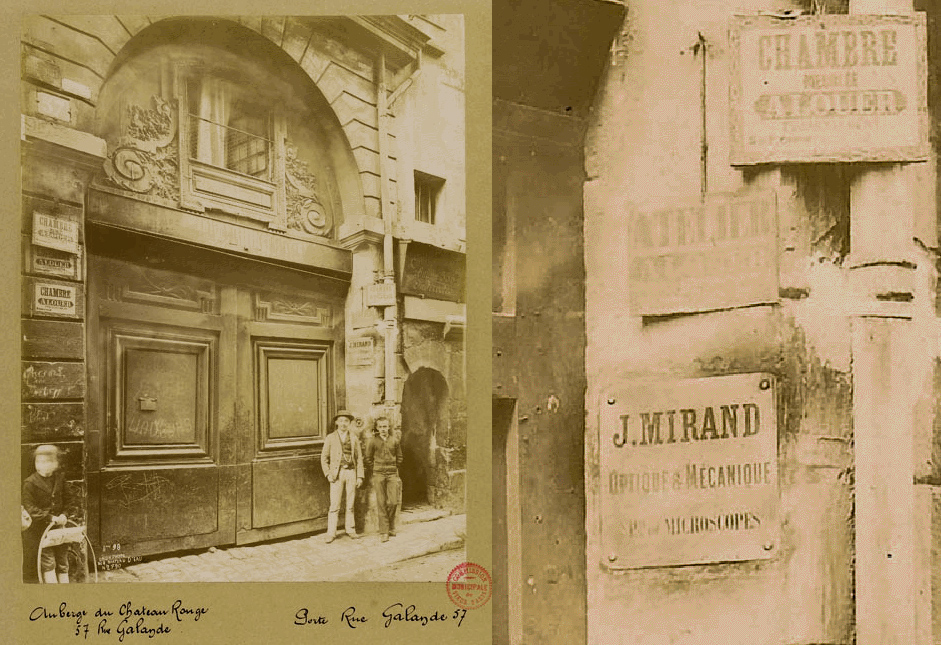
Figure 16.
Rue Galande, 1898, with an enlarged detail showing Mirand's business sign. Adapted for nonprofit, educational purposes from http://parismuseescollections.paris.fr/fr/musee-carnavalet/oeuvres/porte-sur-rue-auberge-du-chateau-rouge-57-rue-galande-5eme-arrondissement and by permission from http://www.lecompendium.com/dossier_optique_238_microscope_mirand/microscope_mirand.htm.
Acknowledgements
Many thanks to Albert Balasse, Joao Inacio Silva, Barry Sobel, Allan Wissner, and Joe Zeligs for generously sharing images and helpful information.
Resources
Album de l'Exposition Universelle (1857) page 257
Annales du Commerce Extérieur (1853) Report of the 1853 New York Exposition, page 21
Annuaire de l'Institut des Provinces, et des Congrès Scientifiques (1854) pages 180-181
Annuaire Général du Commerce at de l'Industrie (1847) Volume 10
Annuaire Général du Commerce at de l'Industrie (1855) page 1177
Annuaire Général du Commerce at de l'Industrie (1862) page 417
Apiculteur (1891) “Diplôme d'honneur: M. Mirand, opticien à Paris, pour ses microscopes et ses loupes”, Vol. 35, page 415
J.A. Berly's British, American and Continental Electrical Directory and Advertiser (1883) “Mirand, fils, rue Galande, 57”, Wm. Dawson & Sons, London, page 605
J.A. Berly's British, American and Continental Electrical Directory and Advertiser (1884) “Mirand Fils., sonneries et signaux electriques, rue Galande, 57, Paris” and “Telegraphie - Mirand, fils, rue Galande, 57, Paris”, Wm. Dawson & Sons, London, pages 17 and 64
Boudet, Jacques (1952) Le monde des Affaires en France de 1830 à Nos Jours, Société d'Édition de Dictionnaires et Encyclopédies, Paris, page 156
Bulletin de la Société d'Encouragement pour l'Industrie Nationale (1854) Pages 16��5-182
Bulletin de la Société Internationale des Electriciens (1885) “Mirand fils (J.), 57, rue Galande, à Paris. - Enregistreur isochrone et signaux électro-magnétiques”, page 102
Bulletin des Lois de la République Franc̜aise (1889) “197999. Brevet de quinze ans , 7 mai 1889; Mirand, à Paris, rue Galande, no. 57 - Compteur de poche produisant le total de toutes dépenses ou recettes au fur et à mesure”, Vol. 1, page 558
Bulletin d'Insectologie Agricole (1880) Vol. 5, page 163
“C” (1867) Exposition Universelle, Hardwicke’s Science-Gossip, Vol. 3, pages 121-122
Catalogue des Brevets d'Invention (1854) “Certif. d'add. pris le 22 mars 1854, par Mirand, mécanicien , à Paris, rue du Petit-Pont, n. 10. (B. du 28 septembre 1852, n. 14604.)”, Ministère de l'Agriculture, page 254
Catalogue Général Officiel, Exposition Internationale d’Électricité, Paris (1881) pa��ges 26 and 52
Catalogue Officiel Publié par Ordre de la Commission Impériale, Exposition Universelle (1855) pages 46 and 54
Description des Machines et Procédés pour Lesquels des Brevets d'Invention (1880) J. Mirand’s patent for the pocket microscope, page 25
France birth, marriage, voter, and death records, accessed through ancestry.fr
Journal de Botanique (1887) Advertisement from J. Mirand, Vol. 1
The Journal of Microscopy (1883) Mirand's revolver microscope, pages 897-898
Journal de Physique, Chimie & Histoire Naturelle Elementaires (1887) Advertisement from J. Mirand, Vol. 3
Journal of the Royal Microscopical Society (1890) Mirand's and Klonne and Müller's Microscopes with revolving stages, page 86
Journal de la Société d’Horticulture de France (1890) “M. Mirand, rue Galande, 57, à Paris. Médaille d'argent, pour son microscope de poche”, Vol. 12, page 272
King, John (1859) The Microscopist's Companion, Rickey, Mallory & Co., Cincinnati
London Gazette (1852) Notice of J. Mirand’s patent in England, page 1074
La Médecine à l'Exposition Universelle de 1867 Guide-Catalogue (1867) Germer-Bailliére, Paris, page 16
microscope-antiques.com (accessed 2018) The lever stages of Alfred White and Cornelius Varley, https://www.microscope-antiques.com/leverstage.html
Official Catalogue of the Industrial Department of the International Exhibition (1862) page 196
Pelletan, Jules (1876) Le Microscope: Son Emploi et ses Applications, Volume 1, Libraire de l’Academie de Medicine, Paris, pages 91 and 147
Pelletan, Jules (1878) La micrographie a l’Exposition de 1878, Journal de Micrographie, Vol. 2, page 447
Peleltan, J. (1889) La micrographie a l’Exposition Universelle de 1889, Journal de Micrographie, Vol. 13, pages 464-467 and 523-524
Rapports du Jury International de l'Exposition Universelle (1867) pages 471-472